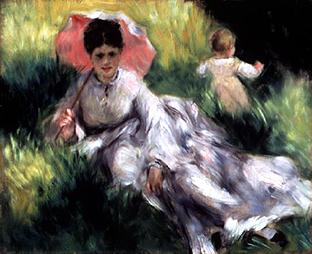|
The international touring exhibition "Monet, Renoir and the Impressionist Landscape" will be on view in Richmond at the Virginia Museum of Fine Arts from Sept.21, 2000, through Dec.10, 2000. The exhibition, which is on view now in Japan and will later travel to Canada, will be shown exclusively on the U.S. East Coast at the Virginia Museum of Fine Arts and will then be exhibited at the Museum of Fine Arts, Houston. "The exhibition brings Virginians a dazzling array of superb Impressionist and Post-Impressionist works, while setting the context for the revolution in 19th century French landscape painting. We at the museum look forward to our visitors enjoying this gorgeous show in the museum 5 beautiful setting. says Katharine C. Lee, director of the Virginia Museum of Fine Arts.
 Pierre-Auguste Renoir, 1874 - 1876. Oil on canvas Dim: 18-1/2x22-1/8. © Museum of Fine Arts, Boston
"This exhibition presents the freshest, brightest and
best The show focuses on landscapes, Cormack says, because "above
all, the Impressionists loved the out-of-doors and painting the
landscape, which they looked at in new ways, capturing the vibrant
effect of light through a heightened More than 60 paintings are shown in the exhibition, ranging in date from the 1830s to about 1900. The exhibition illuminates the development of landscape painting
in France during the 19th century. It makes the point that there
was a division between the Salon (France 5 official art exhibition)
and the new, independent artists who became known as the Impressionists.
 Claude Monet, 1882. Oil on cnvas. Dim 23-7/8x32-1/8 Museum of Fine Arts, Boston
Another five are by Pierre-Auguste Renoir (1841-1919), whose concentration on beautiful scenes - pretty children, flowers, and above all, lovely women - have an instant appeal. Other Impressionists whose work is in the exhibition include Camille Pissarro, Edgar Degas and Alfred Sisley. The exhibition reveals Impressionism's new vision through
comparison with some 19 paintings by the Realists and other landscape
painters who pre Among the precursors of Impressionism represented in the show
are the Barbizon painters, who made up a pioneering group of
French landscape artists Like the Impressionists, the Barbizon artists were advocates
of painting outdoors, directly from nature, but their finished "The Impressionists went a step further than the Barbizon painters by producing works completely painted out-of-doors based on direct observation of nature, brightening the colors in their palettes to capture the changing effect of light on their subjects," Cormack says. The Impressionist's paintings seemed sketchy and unfinished
to many critics of the time. (Today's audience appreciates this
technique for the sense of light, movement and atmosphere that
it gives, but the Salon standard was to The innovations of the Impressionists paved the way for later
artists to experiment even more boldly with color and technique.
In the exhibition's concluding section, landscapes by Post-Impressionist
painters "poignantly demonstrate the lasting impact of the
Impressionists' new vision," Cormack says. The exhibition was organized by the Museum of Fine Arts, Boston, in collaboration with the Nagoya/Boston Museum of Fine Arts on the occasion of its opening in April of this year. The exhibition is accompanied by a catalog written by George Shackelford, the Mrs. Russell W. Baker Curator of European Paintings at the Museum of Fine Arts, Boston. |